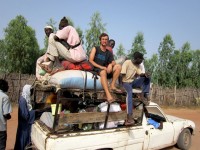This semester, I am studying language and economics in one of West Africa’s largest political, business, and cultural capitals. As an International Affairs and Environmental Studies major, my classes focus on development theories and practice. At I2UD last spring, I researched the classic characteristics of developing cities around the world. And now that I live in Dakar, I have a front row seat to observe just how uneven development affects people’s every-day lives.
From I2UD’s research, I knew many African cities have high urbanization rates and struggle to provide adequate infrastructure like housing and electricity to the influx of migrants. But what does that look like? As home to 25% of the country’s population, Dakar is one such magnet: villagers from the underdeveloped interior come hoping to find upwardly mobile jobs and the basic social services they lack.
Dakar – with its paved roads, cosmopolitan restaurants, nightclubs, and bustling markets – seems like a country apart. But it’s clear the city cannot provide the services demanded by the booming population. Electricity cuts are very common: my house loses power frequently and I have studied by lamplight numerous times. The cuts are new to Senegal and seen as a sign of the state’s corruption. My Senegalese host grandma curses the President every time the lights go off, and riots have occurred on the main road near my school in protest to long outages. Trash collection is also insufficient here: I remember cringing when I discovered that trash is dumped in the street and burned for disposal; now I know that Friday is trash-burning day. Many people even herd goats and sheep in the city, letting them graze through household trash. Despite the construction boom as demand for housing soars, the cluttered slums on the city’s outskirts continue to grow and pose political, health, and planning concerns. I have seen many squatter shacks built in ditches on the side of the road or standing precariously near the edges of sea cliffs.
“Youth bulge” encapsulates Senegal’s population pyramid in an easy textbook phrase; in reality, it is one of the most tragic aspects of Dakar. Many rural families either cannot afford school for their children or don’t live near a school, so they send kids to cities to receive religious educations. Many of these schools, overwhelmed by students or harboring selfish interests, send the children out in droves to beg. Thousands of talibe (religious students) work the streets of Dakar and city officials are unable curb the begging. Outside of a shop or while waiting for a taxi, talibe ask me for money every day.
On a more hopeful note, numerous NGOs and aid agencies work here together with the government, and the country’s solid democracy and stability allow it to implement programs that improve people’s living conditions. And while Dakar could certainly use I2UD’s spatial planning support, the city has many charms. I enjoy the bustling downtown market, a labyrinth of shops bulging with wares from around the world, from vibrant wax-print fabrics and Turkish candies to soccer jerseys and cellphones. The glowing reviews of Senegalese hospitality are all true, as is the great reputation of the food. Dodging chaotic traffic and racing donkey-pulled carts, I know I could never have as fun jogging in Boston as in Dakar. In all, this semester has been a great way for me to connect my schooling and work at the I2UD work to real world phenomena, and I look forward ever more enthusiastically to a career in development.


